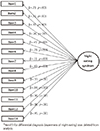2. Birketvedt GS, Florholmen J, Sundsfjord J, Osterud B, Dinges D, Bilker W, et al. Behavioral and neuroendocrine characteristics of the night-eating syndrome. JAMA. 1999; 282(7):657–663.
4. Allison KC, Ahima RS, O'Reardon JP, Dinges DF, Sharma V, Cummings DE, et al. Neuroendocrine profiles associated with energy intake, sleep, and stress in the night eating syndrome. J Clin Endocrinol Metab. 2005; 90(11):6214–6217. DOI:
10.1210/jc.2005-1018.
5. Howell MJ, Schenck CH, Crow SJ. A review of nighttime eating disorders. Sleep Med Rev. 2009; 13(1):23–34. DOI:
10.1016/j.smrv.2008.07.005.
6. de Zwaan M, Roerig DB, Crosby RD, Karaz S, Mitchell JE. Nighttime eating: A descriptive study. Int J Eat Disord. 2006; 39(3):224–232. DOI:
10.1002/eat.20246.
7. Kim MH, Jeong ES, Kim EJ, Cho HK, Bae YJ, Choi MK. Night eating status of university students in partial area of Chungnam. J East Asian Soc Diet Life. 2011; 21(4):563–576.
8. Hong SH, Yeon JY, Bae YJ. Relationship among night eating and nutrient intakes status in university students. J East Asian Soc Diet Life. 2013; 23(3):297–310.
9. Allison KC, Lundgren JD, Moore RH, O'Reardon JP, Stunkard AJ. Cognitive behavior therapy for night eating syndrome: A pilot study. Am J Psychother. 2010; 64(1):91–106.
10. Pawlow LA, O'Neil PM, Malcolm RJ. Night eating syndrome: Effects of brief relaxation training on stress, mood, hunger, and eating patterns. Int J Obes Relat Metab Disord. 2003; 27(8):970–978. DOI:
10.1038/sj.ijo.0802320.
11. Stunkard AJ, Grace WJ, Wolff HG. The night-eating syndrome; A pattern of food intake among certain obese patients. Am J Med. 1955; 19(1):78–86.
12. Vander Wal JS. Night eating syndrome: A critical review of the literature. Clin Psychol Rev. 2012; 32(1):49–59. DOI:
10.1016/j.cpr.2011.11.001.
13. Allison KC, Lundgren JD, O'Reardon JP, Geliebter A, Gluck ME, Vinai P, et al. Proposed diagnostic criteria for night eating syndrome. Int J Eat Disord. 2010; 43(3):241–247. DOI:
10.1002/eat.20693.
14. Allison KC, Lundgren JD, O'Reardon JP, Martino NS, Sarwer DB, Wadden TA, et al. The Night Eating Questionnaire (NEQ): Psychometric properties of a measure of severity of the night eating syndrome. Eat Behav. 2008; 9(1):62–72. DOI:
10.1016/j.eatbeh.2007.03.007.
15. Brislin RW. Back-translation for cross-cultural research. J Cross Cult Psychol. 1970; 1(3):185–216. DOI:
10.1177/135910457000100301.
16. Kim I, Choi H, Kim B. Psychometric properties of Korean version of modified Leeds Sleep Evaluation Questionnaire (KMLSEQ). Korean J Rehabil Nurs. 2014; 17(1):10–17.
17. Cho MJ, Kim KH. Diagnostic validity of the CES-D (Korean version) in the assessment of DSM-III-R major depression. J Korean Neuropsychiatr Assoc. 1993; 32(3):381–399.
18. Cohen S. Laboratory for the study of stress, immunity and disease [Internet]. Pittsburgh, PA: Carnegie Mellon University;2014. cited 2015 July 30. Available from:
http://www.psy.cmu.edu/~scohen/.
19. Linacre JM. FACETS: Rasch measurement computer program. Chicago, IL: Winsteps.com;2005.
20. Seong TJ. Understanding and application of item response theory. Paju: Kyoyookbook;2009.
21. Ware JE Jr., Gandek B. Methods for testing data quality, scaling assumptions, and reliability: The IQOLA project approach. J Clin Epidemiol. 1998; 51(11):945–952. DOI:
10.1016/S0895-4356(98)00085-7.
22. Wright B, Linacre JM. Reasonable mean-square fit values [Internet]. Chicago, IL: Institute for Objective Measurement;2012. cited 2014 August 14. Available from:
http://www.rasch.org/rmt/rmt83b.htm.
23. Linacre JM. Facets: Many-facet rasch measurement tutorials: WINSTEPS & fcets rasch software [Internet]. Beaverton, OR: Winsteps.com;2012. cited 2014 July 7. Available from:
http://www.winsteps.com/tutorials.htm.
24. Allison KC, Engel SG, Crosby RD, de Zwaan M, OReardon JP, Wonderlich SA, et al. Evaluation of diagnostic criteria for night eating syndrome using item response theory analysis. Eat Behav. 2008; 9(4):398–407. DOI:
10.1016/j.eatbeh.2008.04.004.
25. Bond TG, Fox CM. Applying the rasch model: Fundamental measurement in the human sciences. 2nd ed. Mahwah, NJ: Lawrence Erlbaum Associates;2007.
26. Lundgren JD, Allison KC, Vinai P, Gluck ME. Assessment instruments for night eating syndrome. In : Lundgren JD, Allison KC, Stunkard AJ, editors. Night eating syndrome: Research, assessment, and treatment. New York, NY: Guilford Press;2012. p. 197–220.





 PDF
PDF ePub
ePub Citation
Citation Print
Print





 XML Download
XML Download